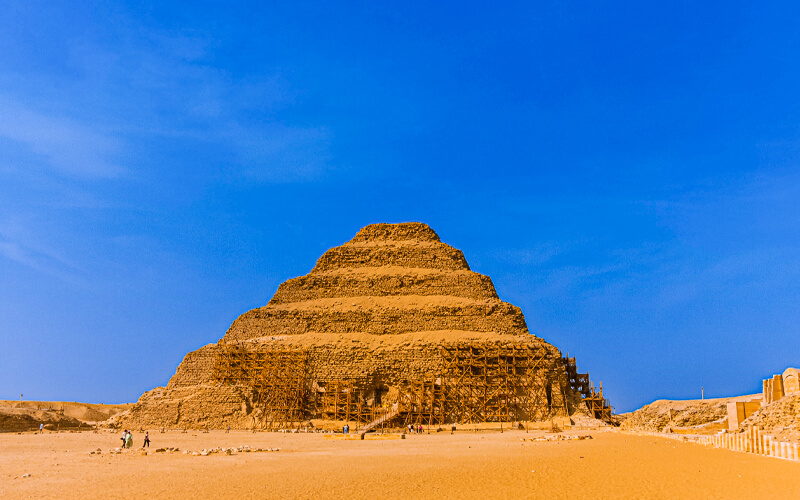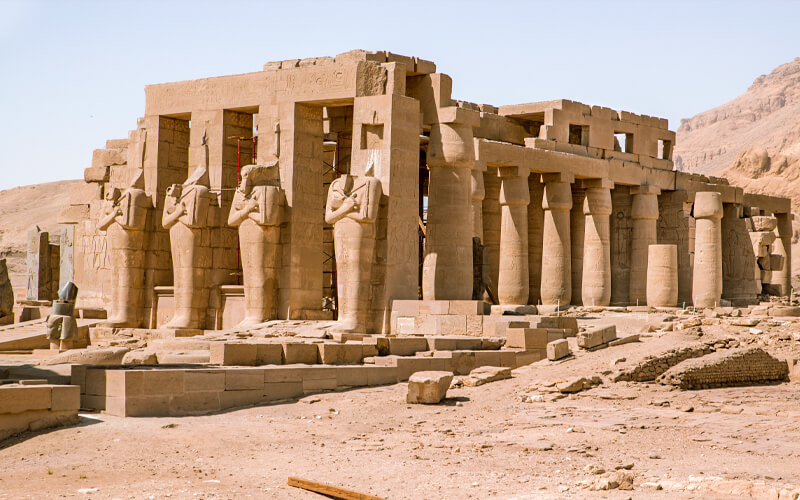Step Pyramid
The Step Pyramid of Saqqara
It is situated west of the Nile, 9 miles (14 kilometers) south of Cairo, and has the pyramid of Djoser, Pharaohs’ houses, columns, and shrines, Mastaba of Mereruka, Pyramid tablets of Una, and the Mastaba of Mereruka. Saqqara is also known as Sakkara in Arabic. The objective of the Saqqara complex is to assist the monarch in having a successful afterlife so that he might be endlessly reincarnated.
Djoser’s complex is the first stone building in Egypt whose architect is known by the name of Imhotep, and it is located in Sakkara, which served as the city’s cemetery. The entrance to Sakkara has a large-scale stone wall that surrounds the complex, and it was dedicated to King Djoser during the third dynasty and was built by architect Imhotep.
To build an enormous mastaba of stone, Imhotep decided to build another mastaba on top of the first, then another on top of the second, and so on until he had enlarged the structure into the world’s first pyramid. The wall surrounding the Djoser complex is made of light Tura limestone and stands 10.5 meters high, with distinctive paneled construction known as the palace façade. It is currently referred to as a “step pyramid,” and it consists of six terraces.
Among the four symbolic buildings in Djoser’s complex in Saqqara are the Pavilion of the North, Pavilion of the South, South Tomb, and Jubilee Festival Courtyard. It is believed that these four symbolic buildings were for the use of the king’s ka, or the afterlife of spirits and that these four symbolic buildings were for the use king’s ka, or the spiritual afterlife.
The original entrance to the Pyramid may be found on the northern side. In addition, you will see a little chamber that has been constructed with a gradient angle, similar to the Pyramid’s own. A stunning limestone statue of King Zoser was discovered and sent to the Egyptian Museum in Cairo, where it was replaced with a replica.
Saqqara’s celebration of the (Hep-Sed) court, which is also known as the (Sed Festival) court, is located within the complex of the Saqqara and is celebrated by the king after 30 years of rule. The celebration is held to rejuvenate the ruler and represent the strengthening of the ruler’s power.
On the southern side, you will find the ruins of the Pyramid of King Unas, also known as the Pyramid of Unas (Unis, Oenas, or Wenis), which dates back to the end of the Fifth Dynasty and is also known as the Pyramid texts. Inside the Pyramid, he put an undecorated black basalt sarcophagus and constructed the walls of his burial chamber out of exquisite colored alabaster. It was the first Pyramid in which inscriptions were found on the inside walls of the burial chamber.
Mereruka’s mastaba is located in the city of Mereruka.
It includes 32 rooms in all, 21 rooms for Mereruka and 6 rooms for his wife Watet-Khet-Hor. It is akin to a palace in design and has 32 rooms in total. The Egyptian nobleman Mereruka served as one of Egypt’s most important officials during the sixth dynasty, during a period when the wealth and authority of state noblemen were expanding.
The Pyramid of Teti is a smooth-sided pyramid located in Egypt’s Saqqara pyramid field. It is named after the Egyptian goddess Teti. It is the second known pyramid to contain pyramid writings in history, and it currently resembles a tiny hill. Below the earth, the chambers and passageways have been kept in excellent condition for thousands of years.
If you want to spend a fantastic vacation check out our amazing Egypt Vacation packages or Cairo Excursions to find the best way to travel to Egypt for you.



